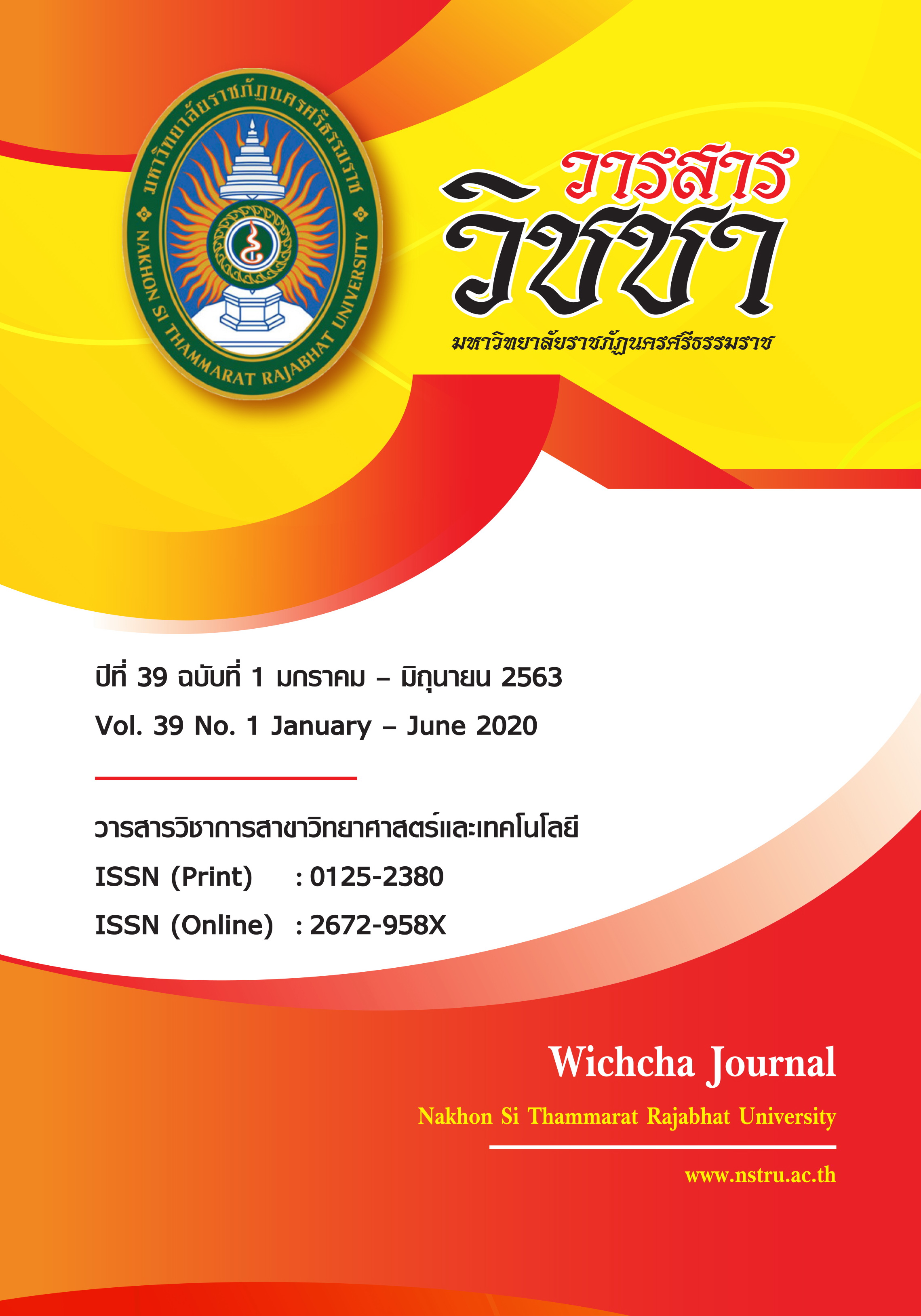Diversity and Distribution of Juvenile Fishes in the Khuan Khee Sean Peat Swamp, Phatthalung Province ความหลากหลายและการกระจายของลูกปลาในพรุควนขี้เสียน จังหวัดพัทลุง
Main Article Content
บทคัดย่อ
ศึกษาความหลากหลายและการกระจายของลูกปลาในพื้นที่พรุควนขี้เสียน จังหวัดพัทลุง โดยเก็บตัวอย่างด้วยเครื่องมืออวนรุน ขนาด 1x1x1 เมตร3 ขนาดช่องตา 1 มิลลิเมตร ทุกสองเดือนระหว่างเดือนสิงหาคม พ.ศ. 2558 ถึงเดือนมิถุนายน พ.ศ. 2559 ใน 6 สถานีสำรวจรอบพื้นที่พรุ โดยมีวัตถุประสงค์เพื่อศึกษาลักษณะทางกายภาพของพรุควนขี้เสียน ประเมินความหลากหลาย ความชุกชุม และการแพร่กระจายของลูกปลา ศึกษาโครงสร้างประชาคมของลูกปลา และประเมินความสัมพันธ์ระหว่างคุณภาพน้ำกับชนิดและปริมาณลูกปลา ผลการศึกษาพบว่า ชนิดลูกปลาที่พบรวมทั้งสิ้น 30 ชนิด จำนวน 14 วงศ์ โดยลูกปลากลุ่มวงศ์ปลาตะเพียนมีความหลากหลายของชนิดพันธุ์มากที่สุดรวม 12 ชนิด และมีปลากริมเพียงชนิดเดียวที่พบในทุกสถานีสำรวจและทุกรอบสำรวจ ค่าผลผลิตทางการประมงพบว่ามีค่าเฉลี่ย 587 ตัวต่อพื้นที่ 100 ตารางเมตร โดยพบปลาหัวตะกั่ว Aplocheilus panchax ปลาซิวหนู Boraras urophthalmoides และปลากริม Trichopsis vittata เป็นองค์ประกอบของโครงสร้างหลัก ซึ่งพบมากที่สุด 3 ลำดับแรก ดัชนีความหลากหลายมีค่าสูงสุดบริเวณตอนบนของพรุ และในเดือนธันวาคม พ.ศ. 2558 เส้นโค้งลำดับความชุกชุมชี้ให้เห็นว่าความชุกชุมของลูกปลาชนิดหลัก 2-3 ชนิดจะมีสัดส่วนมากกว่าร้อยละ 50 ของความชุกชุมในพื้นที่นั้น ๆ ในส่วนรูปแบบของการรวมกลุ่มของลูกปลาในพื้นที่พรุควนขี้เสียนสามารถแบ่งได้เป็น 4 กลุ่ม ซึ่งสัมพันธ์กับแต่ละช่วงเวลาในรอบปี แต่ไม่พบแนวโน้มที่ชัดเจนต่อความสัมพันธ์กับค่าคุณภาพน้ำ
Article Details
เนื้อหาและข้อมูลในบทความที่ลงตีพิมพ์ในวารสารวิชชา มหาวิทยาลัยราชภัฏนครศรีธรรมราช ถือเป็นข้อคิดเห็นและความรับผิดชอบของผู้เขียนบทความโดยตรง ซึ่งกองบรรณาธิการวารสารไม่จำเป็นต้องเห็นด้วยหรือร่วมรับผิดชอบใด ๆ
บทความ ข้อมูล เนื้อหา รูปภาพ ฯลฯ ที่ได้รับการตีพิมพ์ในวารสารวิชชา มหาวิทยาลัยราชภัฏนครศรีธรรมราช ถือเป็นลิขสิทธ์ของวารสารวิชชา มหาวิทยาลัยราชภัฏนครศรีธรรมราช หากบุคคลหรือหน่วยงานใดต้องการนำข้อมูลทั้งหมดหรือส่วนหนึ่งส่วนใดไปเผยแพร่ต่อหรือเพื่อการกระทำการใด ๆ จะต้องได้รับอนุญาตเป็นลายลักษณ์อักษรจากวารสารวิชชา มหาวิทยาลัยราชภัฏนครศรีธรรมราชก่อนเท่านั้น
The content and information in the article published in Wichcha journal Nakhon Si Thammarat Rajabhat University, It is the opinion and responsibility of the author of the article. The editorial journals do not need to agree. Or share any responsibility.
เอกสารอ้างอิง
Ahmad, M.F. and Samat, A. (2015). Species composition and abundance of peat swamp fishes in selected areas of Selangor, Malaysia. Applied Biology, 44(1), 139-145.
APHA. (1989). Standard methods for the examination of water and wastewater. (17th ed). Washington D.C.: American Public Health Association.
Cortizas, A and Chesworth, W. (2006). Peatlands: evolution and records of environmental and climate changes. Elsevier, 9(1), 145-172.
Hsieh, H. and Lo, W. (2019). Mesoscale distribution and assemblage structure of fish larvae in the Kuroshio waters off eastern Taiwan. Marine Biodiversity, 49, 1971-1986.
Jutagate, T., Rattanachai, A., Udduang, S., Lek-Ang, S. and Lek, S. (2016). Fish larvae in a reservoir of the lower Mekong basin: their abundances, relationships to environmental variables and assemblage patterns. Indian Journal of Fisheries, 63(3), 11-23.
Munk, P., Bjørnsen, P.K., Boonruang, P., Fryd, M., Hansen, P.J., Janekarn, V., Limtrakulvong, V., Nielsen, T.G., Hansen, O.S., Satapoomin, S., Sawangarreruks, S., Thomsen, H.A., and Østergaar, J.B. (2004). Assemblages of fish larvae and mesozooplankton across the continental shelf and shelf slope of the Andaman Sea (NE Indian Ocean). Marine Ecology Progress Series, 274, 87-97.
Nagano, T., Osawa, K., Ishida, T., Sakai, K., Vijarnsorn, P., Jongskul, A., Phetsuk, S., Waijaroen, S., Yamanoshita, T., Norisada, M. and Kojima, K. (2013). Subsidence and soil CO2 efflux in tropical peatland in southern Thailand under various water table and management conditions. Mires and Peat, 11(06), 1-20.
Nakhon Si Thammarat Inland Fisheries Research and Devekopment Center. (2018). Biological diversity and fishery resources of the Phru Kuan Kreng Wetland. Retrieved 14 January 2020, From: https://www.fisheries.go.th/sf-nakhonsri/images/research/p_r.pdf.
Ng, P.K.L. and Tan, H.H. (1997). Freshwater fishes of southeast Asia: potential for the aquarium fish trade and conservation issues. Aquarium Science and Conservation, 1(2), 79-90.
Oksanen, J., Blanchet, F.G., Friendly, M., Kindt, R., Legendre, P., McGlinn, D., Minchin, P.R., O'Hara, R. B., Simpson, G.L., Solymos, P., Stevens, M.H.H., Szoecs, E. and Wagner, H. (2019). Vegan: community ecology package. r package version 2.5-5. Retrieved 4 January 2020, From: https://CRAN.R-project.org/package=vegan.
Page, S.E, Rieley, J.O. and Wüst, R. (2006). Lowland tropical peatlands of southeast Asia. In Martini, I.P., Martínez Cortizas, A., and Chesworth, W., (Eds.). Peatlands: evolution and records of environmental and climate changes. Developments in Earth Surface Processes, pp. 145-172.Netherlands: Elsevier Science.
Quist, M.C., Pember, K.R., Guy, C.S. and Stephen, J.L. (2004). Variation in larval fish communities: implications for management and sampling designs in reservoir systems. Fisheries Management and Ecology, 11, 107-116.
R Core Team. (2019). R: a language and environment for statistical computing. R foundation for statistical computing. Retrieved 4 January 2020, From: https://www.R-project.org/.
Schofield, P.J and Schulte, J.M. (2016). Small but tough: what can ecophysiology of croaking gourami, Trichopsis vittata (Cuvier, 1831) tell us about invasiveness of non-native fishes in Florida?. NeoBiota, 28, 51-65.
Sichum, S., Tantichodok, P. and Jutagate, T. (2013). Diversity and assemblage patterns of juvenile and small sized fishes in the nearshore habitats of the gulf of Thailand. The Raffles Bulletin of Zoology, 61(2), 795-809.
Suksri, S. and Boonsoong, B. (2018). The post-larval and juvenile fish assemblage in the Sukhothai floodplain, Thailand. Journal of Oceanology and Limnology, 36(3), 1013-1024.
Sule, H.A., Ismail, A. and Amal, M.N.A. (2016). A review of the ichthyofauna of Malaysian peat swamp forest. Pertanika Journal of Tropical Agricultural Science, 39(4), 421-458.
Vidthayanon, C., (2002). Peat swamp fishes of Thailand. Bangkok: Office of Environmental Policy and Planning.
Yule, C.M. (2010). Loss of biodiversity and ecosystem functioning in Indo-Malayan peat swamp forests. Biodiversity Conservation, 19, 393-409.


